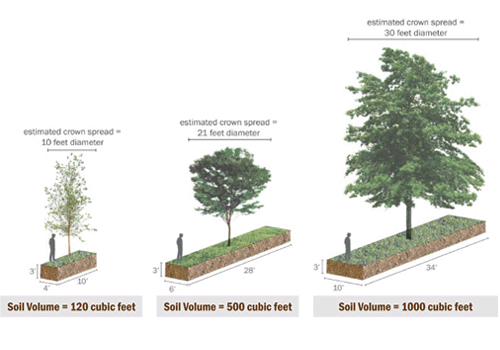S400: The Forgotten Utility for Complete Streets, Safety, and Good Stormwater Design
Much discussion is found on the Interwebs these days about improving communities with “Complete Streets” — streets designed for multiple transportation options and not just for cars. Non-motorized safety is a major focus of such street design, usually achieved by slowing automobile traffic and providing pedestrian safety measures. Vegetation is often used to separate sidewalks from the roadway as well as to increase aesthetics, but all too often the vegetation planting area is treated as an afterthought, and the plant material suffers as a result. Trees are utilities, in that they are excellent coolers, safety barriers, and stormwater mitigators. Unfortunately, their needs are frequently forgotten at design time.
Is there a way to provide for the needs of this forgotten utility and increase the benefits trees provide? Absolutely, and it is relatively easy to do. Simply put, too often woody plants are given inadequate rooting volume and the plant languishes or dies. Most non-desert plants did not evolve surrounded by heat-absorbing and -reflecting concrete, so they must have enough water available to overcome this condition. This is only possible by having enough room for roots to explore for water and nutrients.
First, trees need a minimum volume of soil medium according to their general size (diagram via the Boston Society of Architects):
Next, they need some decent soil to live in, not the compacted, leftover soil found at street construction sites. Fortunately, there are several design and material options beginning to be used, along with numerous structural soil mixtures for use around trees and pavement, such as Bassuk structural soil shown in the adjacent photo.
Large soil volumes — either exposed or under permeable hardscape — not only provide soil for trees but also filter stormwater runoff from the built environment and from trees that have intercepted and collected air pollutants on their surfaces. That’s right: good soil in built environments is important both for plants along our streets and for our stream health.
Notice how I haven’t said anything specific about Complete Street design. That’s because all the products and solutions out there work well with traditional street design as well as modern, innovative design. Nothing about the design itself has to change. Only the specification and construction processes change. And the added value from the benefits from increased tree survivorship ensures the project cost is returned. The project’s triple bottom line is increased simply by paying attention to basic tree needs!
>>>
Dan Staley is an urban planner specializing in green infrastructure on Colorado’s Front Range.



